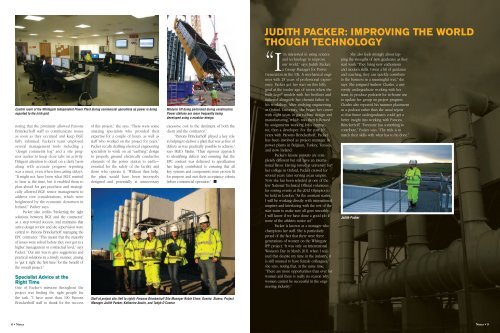Dec 2011 - Parsons Brinckerhoff
Dec 2011 - Parsons Brinckerhoff
Dec 2011 - Parsons Brinckerhoff
Create successful ePaper yourself
Turn your PDF publications into a flip-book with our unique Google optimized e-Paper software.
Using Water to Clean the Air<br />
Minimizing air pollution was a<br />
priority for owner TransCanada<br />
at the Coolidge Generating<br />
Station. The plant runs on<br />
natural gas, which is the cleanest-burning<br />
of the traditional fuel sources. Nevertheless,<br />
all combustion creates nitrogen oxides<br />
(NO X<br />
) when the nitrogen and oxygen molecules<br />
in the air break apart. The higher<br />
the flame temperature, the more NO X<br />
produced. Flame temperatures in turbine<br />
combustion chambers are extremely high—<br />
around 1,100 C (2,000 F)—making NO X<br />
the<br />
primary air pollutant of concern for most<br />
power plants.<br />
Coolidge, like many modern plants,<br />
uses turbine water injection technology to<br />
reduce NO X<br />
air emissions. Water is mixed<br />
with the fuel as it is injected into the combustion<br />
chamber to lower the temperature<br />
of the flame, which in turn lowers the<br />
amount of NO X<br />
produced. Further, because<br />
the water adds mass to the power turbine,<br />
more power is produced for each unit of<br />
fuel burned. That translates to fewer emissions<br />
per MW of electricity produced.<br />
Water injection technology is part of<br />
the General Electric turbine design, but<br />
<strong>Parsons</strong> <strong>Brinckerhoff</strong> was responsible for<br />
engineering the supporting systems. “Water<br />
injected into the turbines must be ultrapure<br />
and demineralized. We designed an<br />
on-site well water supply and a water treatment<br />
facility that works by reverse osmosis<br />
to purify the water. The water piping is<br />
stainless steel to prevent corrosion,” says<br />
Project Manager Colin McRae.<br />
Water injection reduces NO X<br />
emissions<br />
by a factor of about 10 at Coolidge bringing<br />
levels down to 25 parts per million (ppm).<br />
To achieve further reductions, <strong>Parsons</strong><br />
<strong>Brinckerhoff</strong> implemented a selective catalytic<br />
reduction system—similar to the catalytic<br />
converter in a car—to convert NO X<br />
to water<br />
vapor and nitrogen. It reduces stack emissions<br />
to below 2.5 ppm, exceeding environmental<br />
permitting requirements. “The air permit<br />
for this plant only requires a tons-per-year<br />
limit on air pollutants, not the typical (stricter)<br />
parts-per-million limit, but TransCanada wanted<br />
to invest in low emissions,” says McRae.<br />
“Minimizing air pollution is the right thing to<br />
do, and also avoids possible costly retrofitting<br />
in the future if local regulations change.”<br />
At Coolidge Generating Station, routine maintenance is performed on the General Electric LM6000 combustion turbine, an “aero-derivative” turbine—a modified<br />
aircraft engine capable of the fast start-up needed for peaking plants.<br />
and solar power onto the grid because<br />
they can quickly come up to speed on a<br />
still, cloudy day to make up for the fluctuations<br />
in power availability from renewable<br />
sources,” says McRae.<br />
Built for Extremes<br />
The design was developed according to technical<br />
and performance specifications established<br />
by TransCanada. “For example, the<br />
plant design criteria included operation in<br />
ambient temperatures up to 122 F [50 C]—but<br />
it was up to us to determine how,” McRae<br />
explains. “The lubricating oil systems on<br />
peaking turbines are often air-cooled, but<br />
at an ambient air temperature of 122 F, air<br />
cooling won’t work. Therefore, we had<br />
to use a chilled water cooling system. A<br />
cooling tower would have been the typical<br />
solution; however, TransCanada wanted to<br />
minimize the amount of plant wastewater<br />
generated. We designed a closed chilled<br />
water system using mechanical refrigeration—unusual<br />
for a power plant.”<br />
It does get cold on occasion in Phoenix,<br />
so Coolidge also had to be able to handle<br />
freezing temperatures. “If the water vapor in<br />
the air entering the turbines freezes, serious<br />
turbine damage would result,” McRae says.<br />
To prevent the turbines from icing, the team<br />
designed a large electrically heated hot water<br />
closed-loop circulating system to heat the<br />
turbine air intakes.<br />
Coolidge was also required to be a<br />
“zero liquid discharge” plant, meaning all<br />
wastewater goes to lined evaporation ponds<br />
on site rather than to the local sewer system.<br />
Minimizing the amount of wastewater generated<br />
by the plant’s cooling systems made<br />
it possible to design smaller ponds on the<br />
40-hectare (100-acre) site.<br />
Benefits of Tight Teamwork<br />
Several factors contributed to the team’s ability<br />
to complete the project ahead of schedule<br />
and under budget. McRae notes that most<br />
of the <strong>Parsons</strong> <strong>Brinckerhoff</strong> team members<br />
have worked together on numerous power<br />
projects and most are located in the firm’s<br />
San Francisco office, which made coordination<br />
and communication easy and efficient.<br />
Further, <strong>Parsons</strong> <strong>Brinckerhoff</strong> and TIC have a<br />
long history of successful partnership. “That<br />
proven teamwork and trust in our capabilities<br />
appealed to TransCanada. In turn, the team<br />
received the go-ahead to begin engineering<br />
early—while the final plant permits were<br />
being obtained—which was a great advantage<br />
on this project,” McRae says.<br />
Cost savings and better solutions also<br />
came from the nature of the contract. “On<br />
a joint venture, all partners share in the risk<br />
and profit. It helps keep the designer and<br />
the builder working collaboratively to come<br />
up with better ideas that will save money in<br />
the long run,” says McRae. “That’s good for<br />
the joint venture partners, the owner, and the<br />
utility’s customers, who want reliable electricity<br />
at a fair price.” n<br />
Colin McRae<br />
4 • Notes<br />
Notes • 5
















